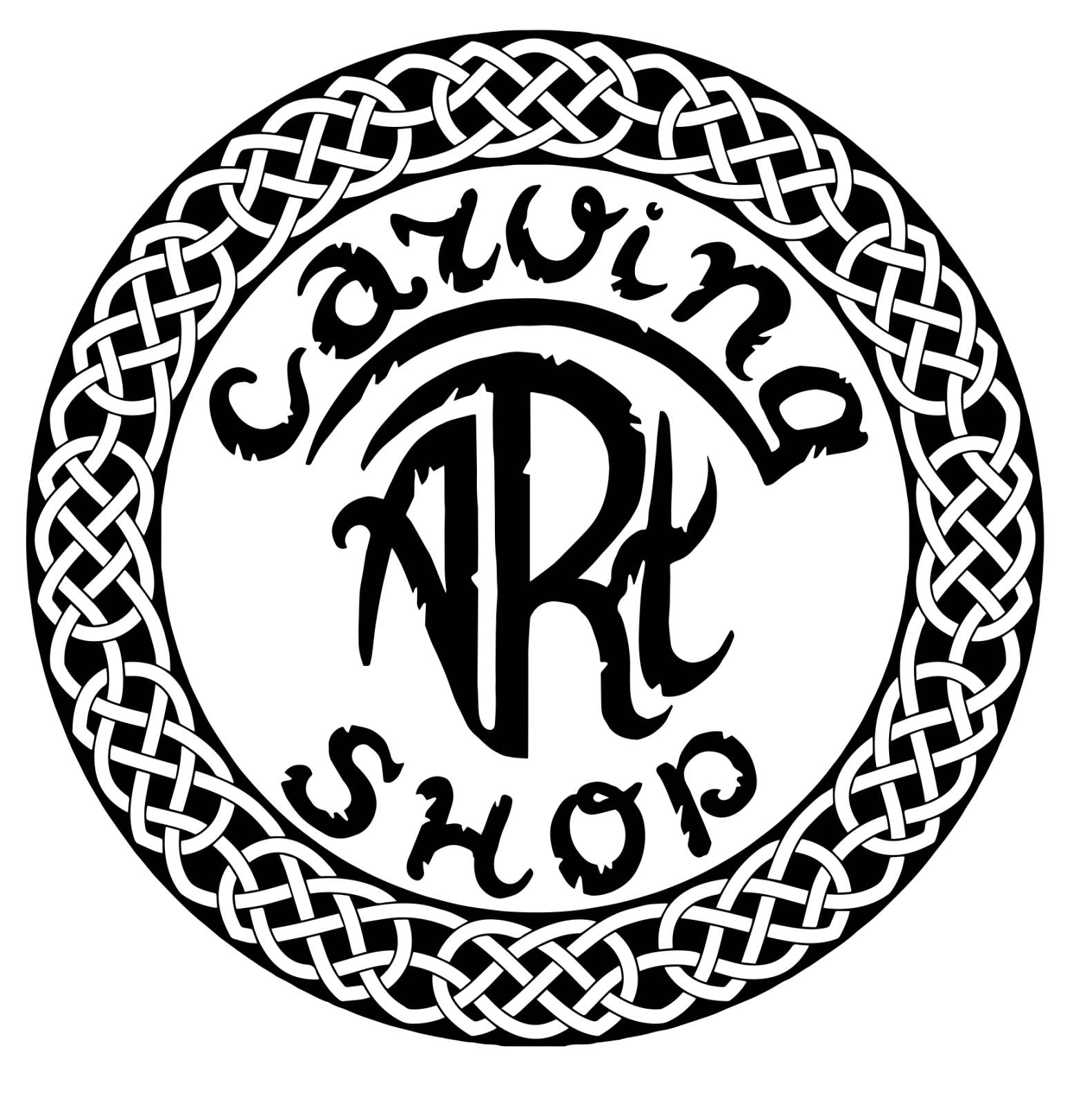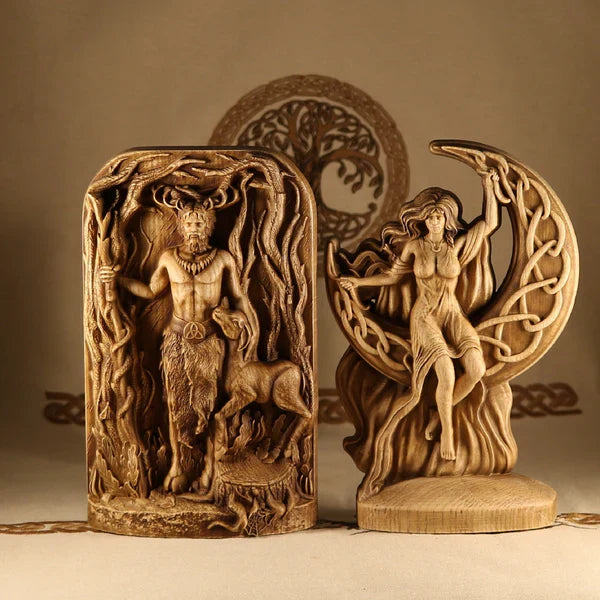Welcome to the world where every wooden figurine carries the history of thousands of years!💫 Celtic mythology is not just a fairy tale of ancient peoples, but a real treasure trove of images, symbols, and magic that still inspire craftsmen and collectors today.
Who are the Celts and why are their myths so special?
The Celts are a mysterious people of Europe whose beliefs are imbued with a connection to nature, spirits, animals, and the forces of the elements. Their mythology is a whole universe where gods and goddesses personify earth, water, war, love, and magic. Unlike many other cultures, the Celts worshipped not only gods but also trees, rivers, stones, and even animals, considering them to be carriers of power and wisdom.
The most famous gods and goddesses of the Celtic world
Danu is one of the most important and mysterious goddesses of Celtic mythology, known as the ancestral mother of the gods and a symbol of fertility, earth and water. She is considered the mother of the Tuatha Dé Danann tribe of gods, a mythical race that, according to legend, ruled Ireland before the arrival of humans.
Main features of Danu👇
-Mother Goddess: Danu personifies the creative power of nature, motherhood, fertility and life-giving energy. She is the ancestor of many Celtic gods, including Dagda, Lug, Nuadu, Brigita, Diane Kecht, Goibniu, and Ogma.
-Water and Earth: Her name is associated with water - rivers, springs, rain - as well as with the earth and the harvest. The names of many European rivers, including the Danube, are associated with her.
-Symbols: Dana is often associated with the river, the earth, a cauldron, ears of grain, as well as birds and children. She personifies spring, youth, love and maternal care.
-She is the patroness of magic and wisdom The tribe of the goddess Danu was considered to be the owners of magical knowledge and arts. Danu is also associated with wisdom and spiritual guidance.
-Mythological: role After being defeated by humans, the Danu tribes, according to legend, retreated into the underworld, becoming inhabitants of the hills - the sidhe, and Danu herself became the patroness of elves and fairies.
Cultural heritage
Danu has left her mark on place names (rivers and places) throughout Europe, and her image still inspires artists, craftsmen, and researchers as a symbol of motherhood, nature, and inexhaustible vitality.
Danu is the embodiment of earth and water power, maternal care, wisdom and magic, the ancestor of the gods and the patron saint of all living things in the Celtic tradition.
One of our Danu statues👀
 Lugh is one of the most important Irish gods in Celtic mythology, known as the god of light, the sun, the arts, crafts, and war. He is often called the "Master of All Trades" (Samildanach) because he had knowledge and skills in many areas: he was a warrior, poet, musician, healer, blacksmith, craftsman, and ruler.
Lugh is one of the most important Irish gods in Celtic mythology, known as the god of light, the sun, the arts, crafts, and war. He is often called the "Master of All Trades" (Samildanach) because he had knowledge and skills in many areas: he was a warrior, poet, musician, healer, blacksmith, craftsman, and ruler.
Main features of Lugh👇
-Solar god and patron saint of the arts Lug is associated with light and the sun, and is also the god of arts, crafts, inventions, and knowledge. His cult was widespread among the Celts in various regions, and city names are derived from his name, such as Lyon (Lugdunum) in France.
-Image and origin: Lug is depicted as a young, handsome warrior with a spear or sling. He was the grandson of Balor, the one-eyed leader of the Fomorians, whom Lug defeated in the legendary Battle of Mag Tuiread, killing his grandfather with a stone from his sling.
-Leader and king: After defeating the Fomor, Lug became the ruler of the tribe of the goddess Danu (Tuatha De Danann) and symbolized a new era of order, art, and prosperity.
-Trickster and hero: In Celtic myths, Lug sometimes appears as a cunning trickster hero, but always remains a positive character who benefits the gods and people.
The holiday of Lugnasad In his honor, Lugnasad, one of the main Celtic harvest festivals, was celebrated.
Lugnasad is the personification of light, creativity, skill, and victory over chaos, a god who inspires development, learning, and art, and protects his followers in battle and life.
One of our Lug statues👀
 Morrigan is one of the most colorful and mysterious goddesses of Celtic (Irish) mythology, known as the "Majestic Queen of Crows" or "Majestic Lady of Crows". She is the goddess of war, death, fate, and transformation, and also personifies female power, magic, and prophecy.
Morrigan is one of the most colorful and mysterious goddesses of Celtic (Irish) mythology, known as the "Majestic Queen of Crows" or "Majestic Lady of Crows". She is the goddess of war, death, fate, and transformation, and also personifies female power, magic, and prophecy.
Main features of Morrigan👇
-Goddess of war and fate: Morrigan was not directly involved in battles, but was always present on the battlefield, influencing the course of events with her magic, enchantments, and prophecies. She could help one side, encourage warriors, or instill fear in enemies.
-A triune goddess In myths, Morrigan often appears as a triune goddess, combining also Badb and Mahu (sometimes Nemain and Phi). This emphasizes her versatility: she can be warlike, prophetic, or destructive.
-The ability to transform: Her most famous image is that of a black raven or crow hovering over a battlefield. But Morrigan can also appear as a beautiful woman, an old woman, a wolf, an eel, or even a cow.
-Prophecy and magic: Morrigan is credited with the gift of foresight, clairvoyance, and powerful spells. She often predicts the fate of warriors and the outcome of battles.
-Sexuality and fertility: In addition to her warrior nature, Morrigan is associated with fertility, sexuality, and maternal power, which allows her to be identified with the Mother Goddess.
Meaning in mythology
Morrigan assisted the Tuatha de Danann gods in decisive battles, and her cult was accompanied by magical rituals and war rites. Her image is a symbol of the inevitability of fate, the power of female magic and transformation, and a mystical connection to the world of the dead and spirits.
Morrigan is the embodiment of a wild, independent force that controls war, life and death, and protects and inspires her followers in the most difficult times.
One of our Morrigan statues👀
Symbols and Animals in Celtic Mythology🐢🦉
Celtic legends are full of images of sacred animals: horses, wolves, crows, deer, and snakes. A special place is occupied by trees - oak, ash, rowan, which were considered to be the gateway to the world of spirits. That's why wooden figurines with Celtic motifs are not just a decoration, but a real amulet that brings the energy of nature and ancient magic into the house.
Why are Celtic figurines more than just decor?❓
Amulet, talisman, gift with a meaning - each wooden statuette with a Celtic motif carries a deep symbolism. It can become your personal source of inspiration, protection, or just a reminder of the beauty of nature and the power of ancient traditions.
Welcome to the world of Celtic legends!❤️
Choose your statuette and let a piece of magic, wisdom and power of Celtic mythology settle in your home.
Your story begins here - with a tree, a legend, and a belief in miracles!❤️


